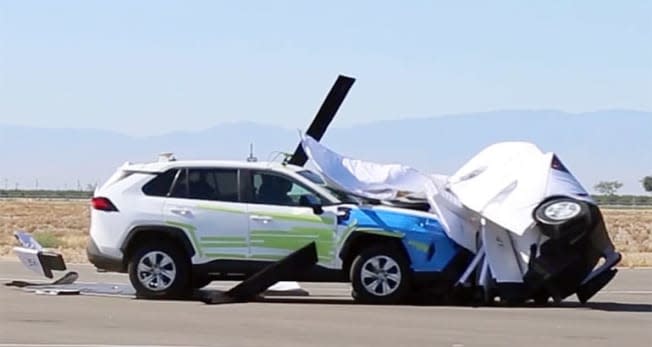New Research Highlights Opportunities to Improve Automatic Emergency Braking
The safety technology needs to evolve to prevent higher-speed crashes, AAA researchers say

By Keith Barry
Automatic emergency braking (AEB) prevents or reduces the impact of low-speed rear-end collisions. But new crash tests from AAA serve as a warning to drivers that the safety technology can’t prevent all crashes.
Automatic emergency braking can detect obstacles and automatically brake to avoid a collision or lessen the severity of impact. But not all AEB systems work at speeds higher than 40 mph, and none are designed to prevent “T-bone” crashes at intersections or left turns in the path of oncoming traffic.
“AEB is still in its infancy, technologically,” says Kelly Funkhouser, CR’s head of connected and automated vehicles. “It is definitely a proven safety feature that should come standard on all cars, but it doesn’t replace an attentive driver behind the wheel.”
To demonstrate what today’s AEB systems can and can’t do, AAA tested four popular AEB-equipped vehicles, simulating common crash scenarios with a foam dummy car. Here’s what happened:
• At 30 mph, the tested AEB systems prevented rear-end collisions with the dummy car in 17 out of 20 test runs. In the 30-mph test runs that resulted in a collision, AEB reduced impact speed by an average of 86 percent.
• At 40 mph, AEB prevented rear-end collisions in only 6 out of 20 test runs and reduced impact speed by an average of 62 percent.
• In a 30-mph perpendicular collision at an intersection, otherwise known as a T-bone crash, AEB didn’t prevent or lessen the impact of any crashes.
• AEB also didn’t prevent or lessen the impact of any crashes involving a left turn in front of an oncoming vehicle.
“We expected the systems to not perform well in intersections but were surprised that we didn’t receive a single alert from any of the vehicles in the intersection scenarios,” Greg Brannon, AAA’s director of automotive engineering and industry relations, told CR. “The capability and sensors are there but need to be tuned for these high risk and complex situations.”
That’s important, because crashes at intersections are responsible for nearly 40 percent of traffic fatalities, according to the organization’s own analysis of crash data from the National Highway Traffic Safety Administration.

A Toyota RAV4 hitting AAA's foam test car in a "T-bone" collision.
Photo: AAA
Even if it can’t prevent a collision, AEB is still beneficial where it can lessen the impact of a crash, says Jennifer Stockburger, director of operations at CR’s Auto Test Center. “Any reduction in speed is beneficial for helping to reduce the potential for injury in a crash,” she says.
AEB is currently standard equipment on almost all new vehicles. Most current systems can also detect pedestrians and some can stop for cyclists, motorcycles, and even large animals. The Insurance Institute for Highway Safety (IIHS) estimates that when combined with forward collision warning (FCW), AEB can reduce rear-end crashes by half. CR currently awards additional points to a vehicle’s Overall Score for models that have AEB with pedestrian detection as standard equipment and for AEB that operates at highway speeds. In order to be named a CR Top Pick, a vehicle must have both.
IIHS has already introduced a new nighttime test to determine how well AEB systems with pedestrian detection can prevent crashes in the dark. The organization already found that such systems have trouble detecting moving pedestrians at night, on roads with speed limits of 50 mph or above, or when a vehicle turns into the path of a pedestrian.

A Chevrolet Equinox hitting AAA's foam test car in a simulation of taking a left turn into oncoming traffic.
Photo: AAA
More from Consumer Reports:
Top pick tires for 2016
Best used cars for $25,000 and less
7 best mattresses for couples
Consumer Reports is an independent, nonprofit organization that works side by side with consumers to create a fairer, safer, and healthier world. CR does not endorse products or services, and does not accept advertising. Copyright © 2022, Consumer Reports, Inc.

